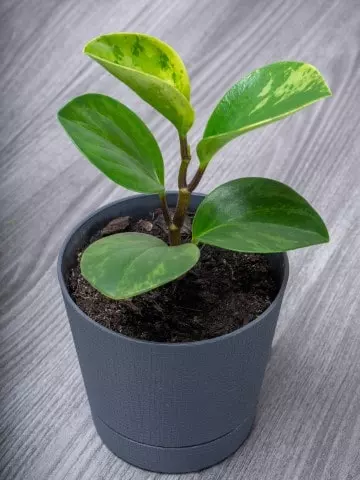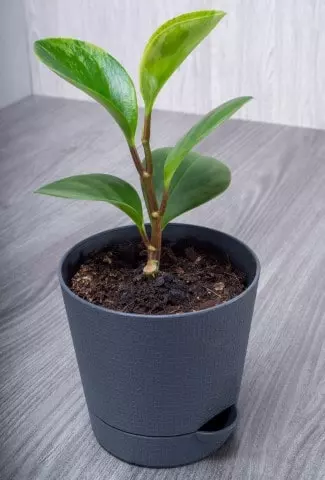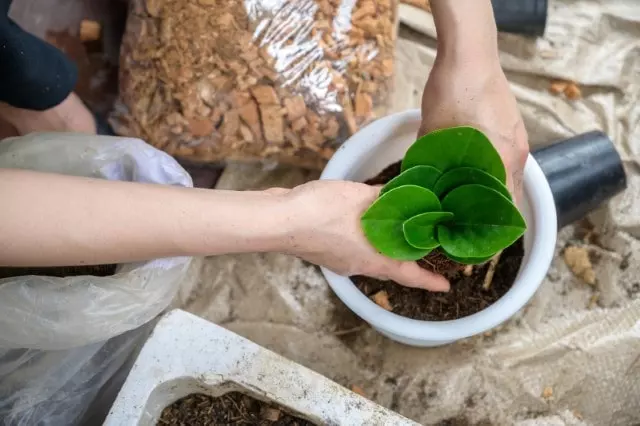Peperomia obtusifolia also known as pepper face or baby rubberplant is a plant, generally cultivated indoors because of its climate requirements, highly valued for its elegant appearance, and the colorful pattern of its leaves. Peperomia obtusifolia care is very simple, so it is also a species suitable for beginners or amateurs without much time.
If you want to learn how to give your plant everything it needs, join us in this article, in which you will find a guide on the care of Peperomia obtusifolia.
Table of Contents
Characteristics of Peperomia obtusifolia
Although its scientific name is Peperomia obtusifolia, we usually refer to it as peperomia veriegata or simply peperomia, it is not the only one of its genus, which has more than 1,000 species. Peperomia obtusifolia is a shrubby plant that initially comes from South America, its stems become inclined and lose verticality, this being part of the natural development process of the plant.
Its most striking feature is its beautiful evergreen leaves, leathery and rounded, which can be bright dark green or variegated, combining green and yellow. Peperomia obtusifolia does not usually grow more than about 10” (25 cm) in both height and width, and its inflorescence appears in a white flower spike, usually in summer. Indoors these do not occur much, but in any case, they are far from being the plant’s most important ornamental feature.

Location of Peperomia obtusifolia
Given its origins in Mexico, Florida, and the Caribbean islands, it is easy to imagine the kind of climate that Peperomia obtusifolia needs. It is because of this that it is usually grown as a houseplant, as Peperomia obtusifolia does not tolerate frost, so in climates, with cold winters the plant cannot be outside unprotected. The ideal climate for baby rubberplant is between 60 °F and 70 °F (16 °C and 21 °C), with the minimum temperature that the plant can withstand without serious damage being 54 °F (12 °C).
As an indoor plant, Peperomia obtusifolia needs a location as bright as possible, usually next to a closed window or other sources of natural light, but always protected from drafts, which are quite harmful.
Outdoors, the ideal is to place it in a semi-shade, i.e. protected from direct sunlight but in an area with a lot of indirect light. Above all, it is important to keep it protected from the midday sun.
- The Peperomia Obtusifolia Red Edge is a bright green plant that has thick and glossy leaves with a deep red edge and stems. This plant, like all Peperomia, like to stay moist but not wet in the soil and need a bright indirect position to thrive.
- Cute little indoor or tropical shade plant with spoon-shaped leaves, deep green and lined around in red. Neat size for baskets and pots. Likes it humid, warm (over 15C), bright but not sunny, and regular light watering.
- Plant in a bright spot with indirect sunlight or dappled shade. Prefers moisture-retaining soil or a good quality potting mix.Enjoys warm humid air and regular light watering with rainwater or filtered water for best results.
Peperomia obtusifolia Watering
Peperomia obtusifolia requires a certain level of humidity, both in the environment and in terms of watering. Therefore, baby rubberplant needs frequent but not too abundant watering, keeping the substrate slightly moist but free of puddles.
In the warm months, the ideal is to water Peperomia obtusifolia approximately every 48 hours, while in the cold ones it is possible to pass to weekly irrigation, always attending to the level of humidity of the substrate or the ground according to the conditions of the local climate.
It also helps a lot to provide ambient humidity to the baby rubberplant if the climate is dry, as is the case in most homes. There are several methods of providing ambient humidity, such as placing cups of water around the plant, changing the water every 3 or 4 days, or placing the pot on a plate containing good-sized stones or pebbles and some water that does not cover them. The latter method ensures that the naturally evaporated water constantly maintains a certain level of humidity around the plant, without damaging its roots.
Peperomia obtusifolia Fertilizer and Substrate
The baby rubberplant is not demanding as far as its soil is concerned, the only really important thing being that it provides good drainage and aeration. Normally, some universal substrate enriched with perlite will suffice. Although, you can always resort to the universal mix we recommend here, with equal parts peat, coconut fiber, and worm castings, plus vermiculite and perlite. As always, this will result in a very nutritious light substrate with great moisture retention properties, but not prone to waterlogging.
As the fertilizer for Peperomia obtusifolia, it will suffice to add some organic fertilizer in the form of organic matter to the base of the plant every 15 days in the warmer months. Use worm humus, compost or bokashi, or liquid fertilizer if you do not have access to any of these fertilizers and have not yet been encouraged to produce them yourself (Fertilizer for Succulents).
- LIGHT APPLICATIONS - A balanced mix of essential nutrients with low NPK rates to gently feed your live cacti and succulents. It help enhance root development, color vibrancy, beautiful bloom, and stem growth in both plant types.
- LASTS LONGER, FOR LESS - Easy, ready to use granular formula feeds your plants consistently for 9 months! Simply poke holes or sprinkle around your pot mix, water, and watch your succulent/cactus thrive! Perfect for pots with pumice, pebbles, gravel, perlite, and other organic potting soil mixes.
- LIQUID ALTERNATIVE - Excellent alternative to liquid fertilizer in a spray bottle. Great for houseplants that need consistent nutrition year round but less watering.

How to Propagate of Peperomia obtusifolia
To Propagate Peperomia obtusifolia is quite simple and can be done by several methods, the easiest and most likely to be successful being to make stem cuttings, especially if done in summer. To do this, follow these steps:
- Disinfect a sharp pair of scissors or knives.
- Cut a cutting of about 4” (10 cm), always choosing a stem that looks healthy and has at least 4 leaves.
- Moisten the base with rooting hormone, which you can make yourself at home with products that everyone has. Here’s how to make natural rooting hormones.
- Plant it in a new pot with a suitable substrate.
- Water generously after planting and keep the plant protected from direct light for the first few days.
We hope this article about Peperomia obtusifolia has been to your liking. We recommend our articles about Peperomia nivalis and Peperomia rotundifolia.



